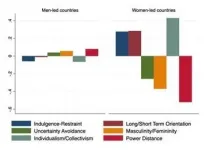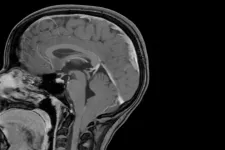(Press-News.org) AMES, Iowa - Nature has figured out how to make great membranes.
Biological membranes let the right stuff into cells while keeping the wrong stuff out. And, as researchers noted in a paper just published by the journal Science, they are remarkable and ideal for their job.
But they're not necessarily ideal for high-volume, industrial jobs such as pushing saltwater through a membrane to remove salt and make fresh water for drinking, irrigating crops, watering livestock or creating energy.
Can we learn from those high-performing biological membranes? Can we apply nature's homogenous design strategies to manufactured, polymer membranes? Can we quantify what makes some of those industrial membranes perform better than others?
Researchers from Iowa State University, Penn State University, the University of Texas at Austin, DuPont Water Solutions and Dow Chemical Co. - led by Enrique Gomez of Penn State and Manish Kumar of Texas - have used transmission electron microscopy and 3D computational modeling to look for answers.
Iowa State's Baskar Ganapathysubramanian, the Joseph C. and Elizabeth A. Anderlik Professor in Engineering from the department of mechanical engineering, and Biswajit Khara, a doctoral student in mechanical engineering, contributed their expertise in applied mathematics, high-performance computing and 3D modeling to the project.
The researchers found that creating a uniform membrane density down to the nanoscale of billionths of a meter is crucial for maximizing the performance of reverse-osmosis, water-filtration membranes. Their discovery has just been published online by the journal Science and will be the cover paper of the Jan. 1 print edition.
Working with Penn State's transmission electron microscope measurements of four different polymer membranes used for water desalination, the Iowa State engineers predicted water flow through 3D models of the membranes, allowing detailed comparative analysis of why some membranes performed better than others.
"The simulations were able to tease out that membranes that are more uniform - that have no 'hot spots' - have uniform flow and better performance," Ganapathysubramanian said. "The secret ingredient is less inhomogeneity."
Just take a look at the Science cover image the Iowa State researchers created with assistance from the Texas Advanced Computing Center, said Khara: Red above the membrane shows water under higher pressure and with higher concentrations of salt; the gold, granular, sponge-like structure in the middle shows denser and less-dense areas within the salt-stopping membrane; silver channels show how water flows through; and the blue at the bottom shows water under lower pressure and with lower concentrations of salt.
"You can see huge amounts of variation in the flow characteristics within the 3D membranes," Khara said.
Most telling are the silver lines showing water moving around dense spots in the membrane.
"We're showing how water concentration changes across the membrane." Ganapathysubramanian said of the models which required high-performance computing to solve. "This is beautiful. It has not been done before because such detailed 3D measurements were unavailable, and also because such simulations are non-trivial to perform."
Khara added, "The simulations themselves posed computtional challenges, as the diffusivity within an inhomogeneous membrane can differ by six orders of magnitude"
So, the paper concludes, the key to better desalination membranes is figuring out how to measure and control at very small scales the densities of manufactured membranes. Manufacturing engineers and materials scientists need to make the density uniform throughout the membrane, thus promoting water flow without sacrificing salt removal.
It's one more example of the computational work from Ganapathysubramanian's lab helping to solve a very fundamental yet practical problem.
"These simulations provided a lot of information for figuring out the key to making desalination membranes much more effective," said Ganapathysubramanian, whose work on the project was partly supported by two grants from the National Science Foundation.
INFORMATION:
The research team
The project was led by Enrique Gomez, a professor of chemical engineering and materials science and engineering at Penn State University, and Manish Kumar, an associate professor of civil, architectural and environmental engineering at the University of Texas at Austin.
Also, from Iowa State University: Biswajit Khara, Baskar Ganapathysubramanian; from Penn State: Tyler Culp, Kaitlyn Brickey, Michael Geitner, Tawanda Zimudzi, Andrew Zydney; from DuPont Water Solutions: Jeffrey Wilbur, Steve Jons; and from Dow Chemical Co.: Abhishek Roy, Mou Paul.
Countries led by women have not fared significantly better in the COVID-19 pandemic than those led by men- it may be just our Western media bias that makes us think they have!
INFORMATION:
Article Title: "Gender in the time of COVID-19: Evaluating national leadership and COVID-19 fatalities"
Funding: The author(s) received no specific funding for this work.
Competing Interests: The authors have declared that no competing interests exist.
Article URL: https://journals.plos.org/plosone/article?id=10.1371/journal.pone.0244531
...
Very low birthweight infants are at a high risk for anemia and often need blood transfusions to survive. Some doctors use a higher level and some use a lower level of red blood cells to order a transfusion. A National Institutes of Health-funded study suggests that providing a higher threshold of red cells within clinically accepted limits (i.e., using a higher level of red blood cells when ordering a transfusion) offers no advantage in survival or reduction in neurological impairment over a lower threshold.
This large, multi-center randomized clinical trial was conducted ...
COLUMBUS, Ohio -- When using social media to nudge people toward safe and healthy behaviors, it's critical to make sure the words match the pictures, according to a new study.
After looking at social media posts, parents of young children were better able to recall safety messages such as how to put a baby safely to sleep when the images in the posts aligned with the messages in the text, the researchers found.
The study appears in the Journal of Health Communication.
"Many times, scientists and safety experts aren't involved in decisions about social media for health agencies and other organizations, and we end up seeing images that have nothing to do with the safety message ...
The scientists from St Petersburg University began to study the geology of Central Asia in the middle of the 20th century. Multi-year research and rich field experience have made it possible to create the world's leading school of thought in the geology of the Tien Shan at the University. At present, work continues with active collaboration with scientists throughout the world.
One of the recent discoveries of the international research team is the discovery of this specific rock assemblage that is characteristic of ...
BOSTON - Reports of possible allergic reactions to the COVID-19 vaccines produced by Pfizer-BioNTech and Moderna, both recently approved for emergency use by the U.S. Food and Drug Administration (FDA), have raised public concern. A team of experts led by allergists at Massachusetts General Hospital (MGH) has now examined all relevant information to offer reassurance that the vaccines can be administered safely even to people with food or medication allergies. The group's review is published in the Journal of Allergy and Clinical Immunology: In Practice.
In response to accounts of potential allergic reactions in some people following COVID-19 ...
People with certain genetic conditions are likely to have significant symptoms of autism, even if they do not meet all diagnostic criteria, a study concludes.
Researchers at Cardiff University say their findings show clinical services need to adapt so that people diagnosed with autism-linked genetic conditions are not denied access to vital support and interventions.
Published in The American Journal of Psychiatry, the international study analysed data from 547 people who had been diagnosed with ...
ADELPHI, Md. -- Multi-domain operations, the Army's future operating concept, requires autonomous agents with learning components to operate alongside the warfighter. New Army research reduces the unpredictability of current training reinforcement learning policies so that they are more practically applicable to physical systems, especially ground robots.
These learning components will permit autonomous agents to reason and adapt to changing battlefield conditions, said Army researcher Dr. Alec Koppel from the U.S. Army Combat Capabilities Development Command, ...
Gallium is a highly useful element that has accompanied the advancement of human civilization throughout the 20th century. Gallium is designated as a technologically critical element, as it is essential for the fabrication of semiconductors and transistors. Notably, gallium nitride and related compounds allowed for the discovery of the blue LED, which was the final key in the development of an energy-efficient and long-lasting white LED lighting system. This discovery has led to the awarding of the 2014 Nobel Prize in Physics. It is estimated that up to 98% of the demand for gallium originates from the semiconductor ...
About one in 100 children has a common brain disorder called Chiari 1 malformation, but most of the time such children grow up normally and no one suspects a problem. But in about one in 10 of those children, the condition causes headaches, neck pain, hearing, vision and balance disturbances, or other neurological symptoms.
In some cases, the disorder may run in families, but scientists have understood little about the genetic alterations that contribute to the condition. In new research, scientists at Washington University School of Medicine in St. Louis have shown that Chiari 1 malformation can be caused by variations ...
Use of the delivery system in mouse models results in unprecedented siRNA penetration across the intact blood brain barrier
Technology could offer potential for a variety of human neurological disorders
In the past few decades, researchers have identified biological pathways leading to neurodegenerative diseases and developed promising molecular agents to target them. However, the translation of these findings into clinically approved treatments has progressed at a much slower rate, in part because ...






